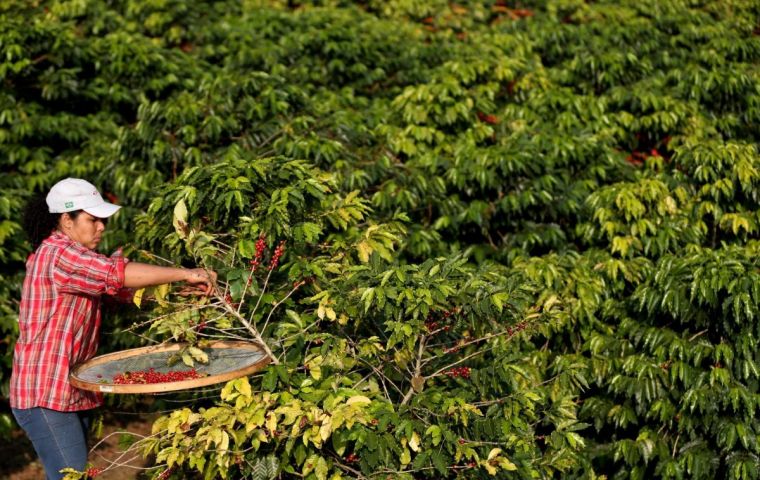MercoPress. South Atlantic News Agency
Brazil: Coffee price expected to remain high
 On the New York Stock Exchange, the main contracts for Arabica coffee reached all-time highs
On the New York Stock Exchange, the main contracts for Arabica coffee reached all-time highs The Brazilian Coffee Industry Association (ABIC) said it expects prices to continue rising in the coming weeks, at least until this year's harvest, which begins around April or May, due to recent adverse weather coupled with increasing global consumption boosted by exports to the newest customer: China.
According to ABIC, this effect on prices should last for another two or three months. After that, the value of the product should cool down, with some stabilization. However, the fall in prices should not occur until next year's harvest.
The rise in coffee prices has been observed since November and is not limited to Brazil, the world's leading coffee exporter with 40% of global production, followed by Vietnam (around 17%) and Colombia.
In 2020, the Brazilian harvest broke records, but the following years were not as good due to climatic events. In 2021, a frost decimated almost 20% of the Arabica crop. In 2022, it was unable to recover because it takes two years to harvest, explained ABIC.
In 2023, the crop suffered the effects of El Niño - a phenomenon that affects the climate across the planet - with prolonged drought and high temperatures. And last year, La Niña brought prolonged rains.
“This is very bad for the harvest,” explained ABIC President Pavel Cardoso. The crop that will be harvested this year will be slightly smaller than last year's, he also noted. “This accumulation of four years of climate problems and the growth in global demand explains this increase in coffee prices,” he stressed.
With all these climate problems affecting the crop, production costs have gone up. Only 38% of these adjustments were passed on to customers. All of these factors combined have contributed to the rise in commodity prices on international exchanges, which has had an impact on consumers' wallets. On the New York Stock Exchange, major contracts for Arabica coffee reached all-time highs.
“Much of this record, which is approaching US$ 4 per pound, has been attributed to the potential increase in supply. It is a strong inflow of funds that is generating a historic number, but it is potentially important for the entire sector to reflect on. Is this a win-win situation for everyone? It is a situation that we all need to think about,” said Cardoso. “This escalation will stop at some point, but we don't know when. That is the question we are all asking ourselves.”
The ABIC expects this year's harvest to help stabilize prices, while next year's could break the 2020 record, increasing supply and lowering prices. Until then, consumers are to face higher coffee prices.
“In terms of the commodity, we should still have some additional volatility until the harvest arrives, which should create tension due to a very short supply. Once the crop arrives, we understand that there will be some stability. And when we have the harvest, so looking ahead to 2026, we expect to have a large harvest, possibly larger than 2020, when we had a record harvest,” Cardoso also said.
“As far as the consumer is concerned, we will have some additional increase, because we had an increase of more than 180% for the industry, which absorbed this increase and passed part of it on to the markets, reaching 37% for the consumer. So part of this increase will be passed on to retailers and therefore to consumers,” he also noted.
Coffee consumption in Brazil between November 2023 and October 2024 grew 1.11% year over year, according to ABIC data released Wednesday.
Brazil is the second largest coffee consumer in the world, with 21,916 billion bags in 2024, or 4.1 million bags less than the United States. Brazilians consume an average of 1,430 cups of coffee per year.
In the last four years, the raw material has increased by 224% and retail coffee has increased by 110%. Last year, the consumer price variation for roasted and ground coffee was 37.4%, a higher increase than the average for the basic food basket (2.7%).
(Source: Agencia Brasil)




Top Comments
Disclaimer & comment rulesCommenting for this story is now closed.
If you have a Facebook account, become a fan and comment on our Facebook Page!